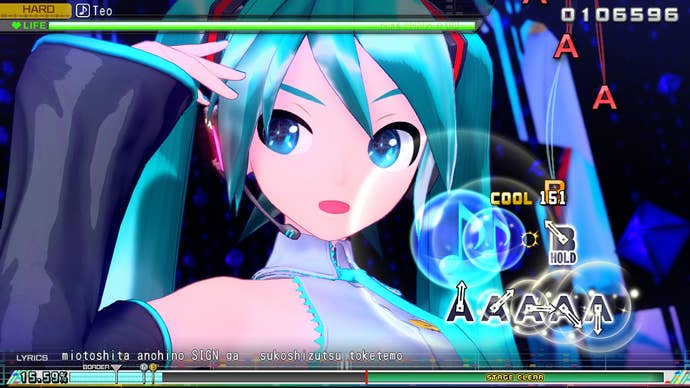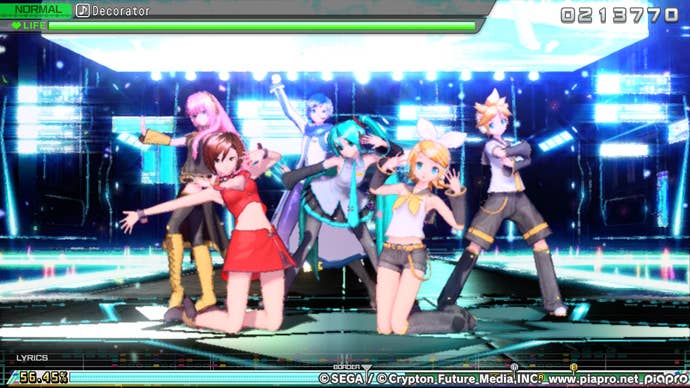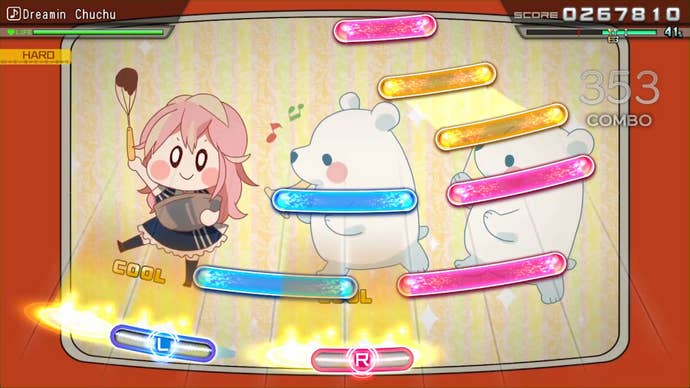Hatsune Miku: Project Diva Mega Mix Review: Sadistic Music Factory
Project Diva returns to a portable platform, but how does it stack up to the rest of the series?
This article first appeared on USgamer, a partner publication of VG247. Some content, such as this article, has been migrated to VG247 for posterity after USgamer's closure - but it has not been edited or further vetted by the VG247 team.
I subscribe to two thoughts when it comes to rhythm games.
- They are at their best either in arcades or in the palm of one's hand, be it portable or mobile.
- They are only good if they are actually about keeping a rhythm, and not just set to music.
Quite a few rhythm games fail in either category. Perhaps the sole exception also doubles as one of my favorite rhythm games: Hatsune Miku: Project Diva Future Tone, a PlayStation 4 exclusive that violated the second rule in 2017.
Much as I would have preferred it to be portable, Future Tone managed to be an incredible package. It was all Project Diva, but with none of the fluff of the portable console entries before it. We didn't decorate Vocaloids' rooms anymore, nor did we bond with them by giving Miku melon soda or whatever. It was just hundreds of songs—a huge number above the standard 30+ from early games in the rhythm series—with a lot of flexibility in terms of difficulty. Of course, collecting outfits and accessories through earned in-game currency played a big role too. I missed the other elements (minus the creepy head patting), but the sheer breadth of songs to play made up for it. It still remains on my PS4's hard drive, which is practically unheard of given the number of games I cycle through every month. You never know when you want to pop in a round of "PoPiPo."

Hatsune Miku: Project Diva Mega Mix feels like a toned down version of Future Tone. It doesn't boast as big of a track list, though it still teeters over just a hundred at 101. Nor does it have the extra features that helped round out the excellent Project Diva F games. Instead, it's biggest strength is that it's portable, which is made doubly sweet when considering the sheer scope of its tracklist. There's rock, typical Vocaloid J-Pop, ballads, and more. Players can craft their own custom playlists, or just favorite tracks for their own favorites section. I do the latter.
In that sense, Hatsune Miku: Project Diva Mega Mix is a return to form of sorts. Years ago on PlayStation Vita, I played through Project Diva F and its even-better sequel, and practically wore out the buttons on the portable console because of it. While I love Future Tone, it was always missing that on-the-go capability. Thankfully, the Project Diva formula translates very well to Nintendo's half-portable machine, even if my brain is engineered to only recognize the familiar shapes of DualShock buttons as they dance on screen in beat. It took some getting used to correctly hitting B, A, Y, and a non-blue X instead.
Project Diva Mega Mix follows the same excellent rhythm game formula the series has always stuck with. Symbols fly onto the screen; I tap them in accordance to the rhythm of the song. Some songs have fast BPM, while others move to a more even rhythm. A slower tempo doesn't mean a song is easier, though. In fact, I often find it even harder to keep with the rhythm on tracks that aren't at a high speed. Regardless, it's all tough, which is to be expected of Project Diva. Even Normal can be a brutal challenge. Clearing a song on Hard nets additional difficulty options: Extreme and sometimes Extra Extreme, which is only available for some songs. I have yet to clear anything on either. Mega Mix may be a cute-looking rhythm game, but it's not to be underestimated.
Admittedly, Vocaloid music isn't the sort of tunes I listen to in my day to day. But back when I got into the Project Diva series nearly a decade ago, I was in my peak J-Pop fandom. I saw the likes of Kyary Pamyu Pamyu and Perfume in concert. I even saw Hatsune Miku herself once, as a hologram of course. Nowadays, I'm more into K-Pop and American pop music. Still, when I play a Hatsune Miku game nowadays, I find it's easy to fall back into the effervescent, digital pop.
The Project Diva games are led by the all-stars of the Vocaloid world: Hatsune Miku, Megurine Luka, Kagamine Rin and Len, Meiko, and Kaito. Vocaloids, for the uninitiated, are basically digital instruments that producers sculpt into de facto pop stars. Fans of the humanized software across the world write lyrics and compose songs for Miku and other Vocaloids, and share their music. The Project Diva series from Sega, basically, gives the music an even bigger platform beyond the niche fandom. We're reminded of it constantly too—every song starts with credits to who wrote and produced the song, and every screenshot snapped in-game is slapped with a giant copyright in the bottom corner—as if to constantly remind me of how much individual licensing it takes just to make this rhythm game possible.
Compared to past Project Diva games, the tracklist in Mega Mix seems even more skewed toward Miku-led songs than normal, with only a handful devoted to her comrades. Some fan-favorite songs are notably absent from the tracklist too, like the infectiously bouncy "Clover Club." Luckily, a healthy dose of new tracks to the series livens up the tracklist in those slight absences. There's also DLC for Mega Mix—there's a Nintendo eShop button in the main menu for it—so I wouldn't be surprised to see the biggest omissions in the base game return in that capacity.
Despite portable being my preferred way to play, Mega Mix unfortunately suffers in visuals when shrunk down. Unlike what I recall of the polished visuals of the PlayStation Vita and the charm of the chibi-fied Nintendo 3DS spin-off Project Mirai DX, Mega Mix looks blurry when the video playing behind the rhythm game is in 3D—which is most of the time. It's the same issue I've seen with a lot of triple-A ports and other games that don't optimize well for the portable usage of the Switch: tiny text; blurry visuals. Luckily, the game itself still performs and plays well when portable, which is all that really matters.

On TV, meanwhile, Mega Mix looks perfectly fine. It's a shame that it's in no way how I want to play the game though. Notably, Mega Mix also throws in a new playstyle: Mix Mode. Mix Mode utilizes the Switch's Joy-Cons, as players wave each one and hit the back triggers to the beat. In theory, it sounds like it could be a fun Wotagei-style, joystick-waving activity. In practice, it's kinda miserable.
Even helpfully adjusting the settings to account for TV and sound lag—my soundbar, when uncalibrated, is always just off unfortunately—Mix Mode is plainly never fun. In it, the right and left Joy-Con are represented by a flat bar, which can move right to left on the bottom of the screen. It reminds me immediately of the Persona rhythm games, wherein the music notes flow to certain corners of the screen always. In Mix Mode, when the note hits the designated bottom area of the screen, the player hits the rear bumper, getting the note.
But the Joy-Cons never move smoothly from side-to-side on the screen. The sound mixing in the mode is also weirdly off, as successfully hitting the notes sounding way louder than in the traditional mode. After playing a handful of favorite songs in Mix Mode and testing out the sparse difficulty levels—as there are only three difficulty levels, compared to the base mode's four-to-five—I don't have the desire to ever return to Mix Mode.
Another new addition exclusive to Mega Mix is the T-Shirt Editor. With the T-Shirt Editor, Vocaloids can wear custom shirts that players design, with five save slots available. The T-Shirt Editor tools aren't super robust, featuring a paint bucket, eraser, and varied size of paintbrushes. There isn't a grid print on the test shirt either, making it undoubtedly harder for folks who might want to make more precise designs. Still, it's a nice addition for the more creative-minded Miku fans.

Ultimately, however, all the blemishes of clunky motion rhythm gaming and downright ugly visuals-scaling fades away when I get into the zone. It's the sort of rhythm game that I know will stay on my Switch Lite for some time, like the underrated Voez before it. Project Diva Mega Mix will always be prepared to occupy the spare moments while I'm waiting for water to boil on the stove, or when I'm at the laundromat. With 101 songs and more costumes and accessories than I can feasibly count—yes, the strange Sonic the Hedgehog costume is back—there's a lot of content here for rhythm game and Vocaloid fans to wave their leeks to. I, for one, will be back to try and get perfect scores on my favorite tracks, from the Perfume-like "The MMORPG Addict's Anthem," to the devilishly catchy "Freely Tomorrow." Maybe one day I can overcome one of those on Extreme difficulty, too. Who knows. All I know is the world is Miku's, and her world, for a time, is mine on Switch.
ConclusionProject Diva Mega Mix is a welcome return to Nintendo's portable platform for the rhythm game series. While it doesn't scale well to portable and its Joy-Con motion control mode is a dud, the main mode remains as brutally satisfying as ever. Whether a diehard Miku fan or just a rhythm game enthusiast, Hatsune Miku: Project Diva Mega Mix is yet another great entry in the series.










